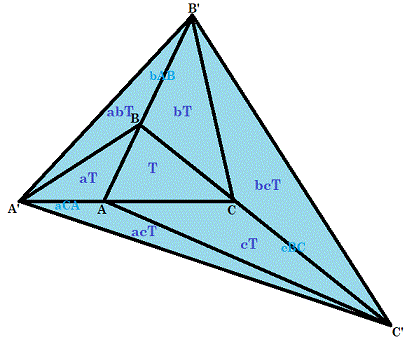Extension and new area
Given △ A B C , a new triangle △ A ′ B ′ C ′ is generated as follows:
- Extend A B to B ′ such that B B ′ = A B
- Extend B C to C ′ such that C C ′ = B C
- Extend C A to A ′ such that A A ′ = C A
Find the ratio of the area of the new triangle to the original triangle, i.e. find [ A B C ] [ A ′ B ′ C ′ ]
This section requires Javascript.
You are seeing this because something didn't load right. We suggest you, (a) try
refreshing the page, (b) enabling javascript if it is disabled on your browser and,
finally, (c)
loading the
non-javascript version of this page
. We're sorry about the hassle.
2 solutions

Let T be the area of △ A B C .
If A A ′ = a C A , then △ B A A ′ has the same height as △ A B C but a base of a C A instead of C A , so △ B A A ′ has an area of a T .
If B B ′ = b A B , then △ C B B ′ has the same height as △ A B C but a base of b A B instead of A B , so △ C B B ′ has an area of b T .
If C C ′ = c B C , then △ A C C ′ has the same height as △ A B C but a base of c B C instead of A B , so △ A C C ′ has an area of c T .
Also if A A ′ = a C A , then △ C ′ A A ′ has the same height as △ A C C ′ but a base of a C A instead of C A , so △ C ′ A A ′ has an area of a c T .
Also if B B ′ = b A B , then △ A ′ B B ′ has the same height as △ B A A ′ but a base of b A B instead of A B , so △ A ′ B B ′ has an area of a b T .
Also if C C ′ = c B C , then △ B ′ C C ′ has the same height as △ C B B ′ but a base of c B C instead of B C , so △ B ′ C C ′ has an area of b c T .
Therefore, the ratio of areas of △ A ′ B ′ C ′ to △ A B C is T T + a T + b T + c T + a b T + a c T + b c T = 1 + a + b + c + a b + a c + b c .
In this case, a = b = c = 1 , so the ratio of areas is 1 + 1 + 1 + 1 + 1 ⋅ 1 + 1 ⋅ 1 + 1 ⋅ 1 = 7 .
Connect B ′ C .
We have [ B B ′ C ] = [ A B C ] since A B = B B ′ .
We also have [ B ′ C C ′ ] = [ B B ′ C ] since B C = C C ′ .
Similarly, we have [ A B C ] = [ B B ′ C ] = [ C C ′ A ] = [ A A ′ B ] = [ B ′ C C ′ ] = [ C ′ A A ′ ] = [ A ′ B B ]
However, [ A ′ B ′ C ′ ] = [ A B C ] + [ B B ′ C ] + [ C C ′ A ] + [ A A ′ B ] + [ B ′ C C ′ ] + [ C ′ A A ′ ] + [ A ′ B B ] , hence the answer is 7.